一般现在时、一般过去时、一般将来时、现在进行时
- 格式:docx
- 大小:27.21 KB
- 文档页数:8
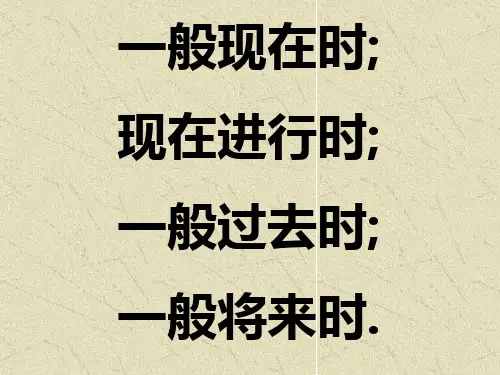
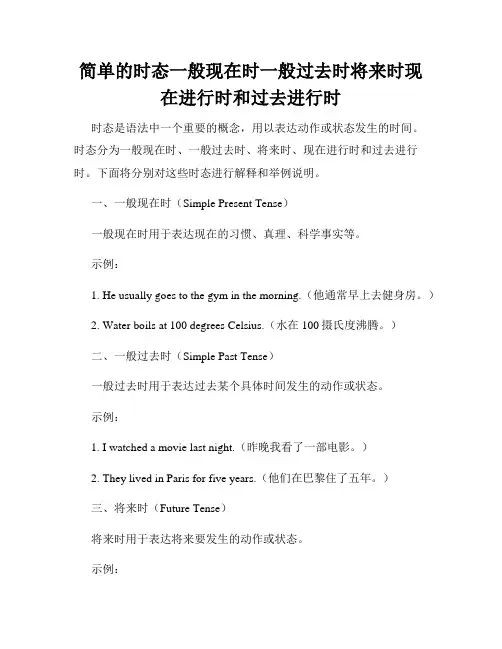
简单的时态一般现在时一般过去时将来时现在进行时和过去进行时时态是语法中一个重要的概念,用以表达动作或状态发生的时间。
时态分为一般现在时、一般过去时、将来时、现在进行时和过去进行时。
下面将分别对这些时态进行解释和举例说明。
一、一般现在时(Simple Present Tense)一般现在时用于表达现在的习惯、真理、科学事实等。
示例:1. He usually goes to the gym in the morning.(他通常早上去健身房。
)2. Water boils at 100 degrees Celsius.(水在100摄氏度沸腾。
)二、一般过去时(Simple Past Tense)一般过去时用于表达过去某个具体时间发生的动作或状态。
示例:1. I watched a movie last night.(昨晚我看了一部电影。
)2. They lived in Paris for five years.(他们在巴黎住了五年。
)三、将来时(Future Tense)将来时用于表达将来要发生的动作或状态。
示例:1. We will have a meeting tomorrow.(我们明天要开会。
)2. She is going to travel to Japan next month.(她下个月将要去日本旅行。
)四、现在进行时(Present Continuous Tense)现在进行时用于表达正在进行的动作。
示例:1. They are watching TV at the moment.(他们此刻正在看电视。
)2. She is studying for her exam right now.(她正在复习考试。
)五、过去进行时(Past Continuous Tense)过去进行时用于表达过去某一时刻正在进行的动作。
示例:1. I was reading a book when she called.(她给我打电话的时候,我正在看书。
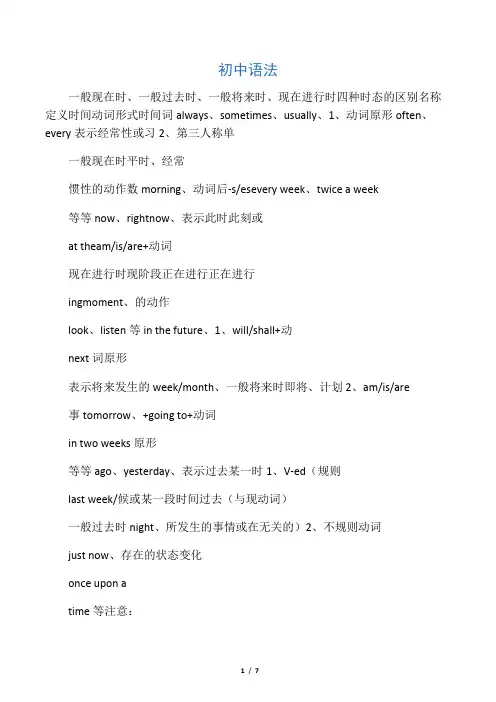
初中语法一般现在时、一般过去时、一般将来时、现在进行时四种时态的区别名称定义时间动词形式时间词always、sometimes、usually、1、动词原形often、every表示经常性或习2、第三人称单一般现在时平时、经常惯性的动作数morning、动词后-s/esevery week、twice a week等等now、rightnow、表示此时此刻或at theam/is/are+动词现在进行时现阶段正在进行正在进行ingmoment、的动作look、listen等in the future、1、will/shall+动next词原形表示将来发生的week/month、一般将来时即将、计划2、am/is/are事tomorrow、+going to+动词in two weeks原形等等ago、yesterday、表示过去某一时1、V-ed(规则last week/候或某一段时间过去(与现动词)一般过去时night、所发生的事情或在无关的)2、不规则动词just now、存在的状态变化once upon atime等注意:1、一般现在时——第三人称单数的动词变化规则:1)大多数动词在词尾加“S”如:stop-______; make-______read-______; play-______2)以辅音字母加“y”结尾的,要先将“y”变为“i”,然后在加“es”如:fly-______;carry-______study-______; worry-______3)以“s, x, ch, sh”结尾的,在词尾加“es”如:teach-______;watch-______4)以“o”结尾的动词,加“es”如:go-______do-______2、现在进行时——动词ing形式的变化规则1.一般动词直接在词尾+ing例:read→______(读)talk→______(交谈)sing→______(唱歌)2.以不发音e结尾的动词,先去e再加ing例:like→______喜欢write→______写skate→______(滑冰)3.以重读闭音节结尾且末尾只有一个辅音字母的动词,双写末尾字母,再加ing例:stop→______(停止)get→______(得到)4.少数几个以ie结尾的动词,变ie为f再加ing。
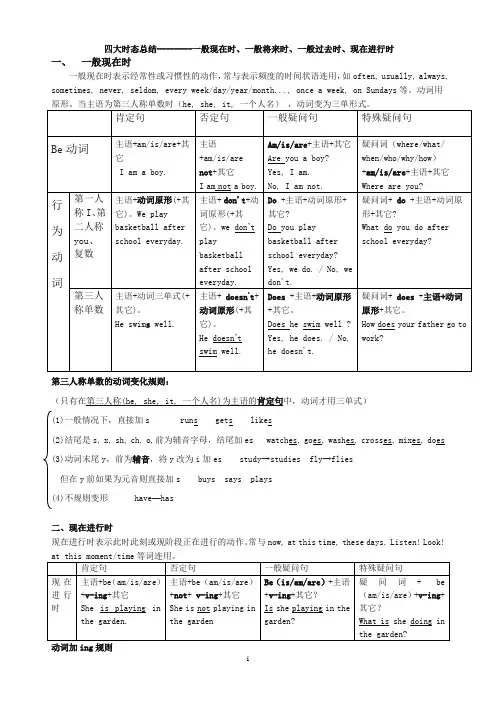
四大时态总结--------一般现在时、一般将来时、一般过去时、现在进行时一、一般现在时一般现在时表示经常性或习惯性的动作,常与表示频度的时间状语连用,如often, usually, always, sometimes, never, seldom, every week/day/year/month..., once a week, on Sundays等。
动词用第三人称单数的动词变化规则:(只有在第三人称(he, she, it, 一个人名)为主语的肯定句中,动词才用三单式)(1)一般情况下,直接加s runs gets likes(2)结尾是s, x, sh, ch, o,前为辅音字母,结尾加es watches, goes, washes, crosses, mixes, does(3)动词末尾y,前为辅音,将y改为i加es study→studies fly→flies但在y前如果为元音则直接加s buys says plays(4)不规则变形 have—has二、现在进行时现在进行时表示此时此刻或现阶段正在进行的动作。
常与now, at this time, these days, Listen! Look!动词加ing规则(1)直接在动词后加ing. going, starting, working.(2)去掉词尾不发音的e,再加ing. leave--leaving, make---making.注意:如果单词结尾的e发音,则不能去掉,也直接加ing. see –seeing agree - agreeing .(3) 对于动词只有一个元音,而其后跟了一个辅音字母时,双写末尾辅音字母再加ing.sitting, beginning run –running stop –stopping cut –cutting control –controlling(4)以ie结尾,把ie变y再加ing。
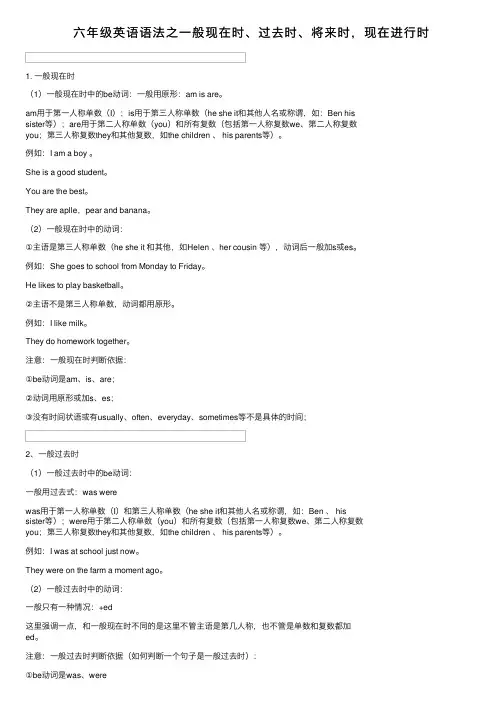
六年级英语语法之⼀般现在时、过去时、将来时,现在进⾏时1. ⼀般现在时(1)⼀般现在时中的be动词:⼀般⽤原形:am is are。
am⽤于第⼀⼈称单数(I);is⽤于第三⼈称单数(he she it和其他⼈名或称谓,如:Ben hissister等);are⽤于第⼆⼈称单数(you)和所有复数(包括第⼀⼈称复数we、第⼆⼈称复数you;第三⼈称复数they和其他复数,如the children 、 his parents等)。
例如:I am a boy 。
She is a good student。
You are the best。
They are aplle,pear and banana。
(2)⼀般现在时中的动词:①主语是第三⼈称单数(he she it 和其他,如Helen 、her cousin 等),动词后⼀般加s或es。
例如:She goes to school from Monday to Friday。
He likes to play basketball。
②主语不是第三⼈称单数,动词都⽤原形。
例如:I like milk。
They do homework together。
注意:⼀般现在时判断依据:①be动词是am、is、are;②动词⽤原形或加s、es;③没有时间状语或有usually、often、everyday、sometimes等不是具体的时间;2、⼀般过去时(1)⼀般过去时中的be动词:⼀般⽤过去式:was werewas⽤于第⼀⼈称单数(I)和第三⼈称单数(he she it和其他⼈名或称谓,如:Ben 、 hissister等);were⽤于第⼆⼈称单数(you)和所有复数(包括第⼀⼈称复数we、第⼆⼈称复数you;第三⼈称复数they和其他复数,如the children 、 his parents等)。
例如:I was at school just now。
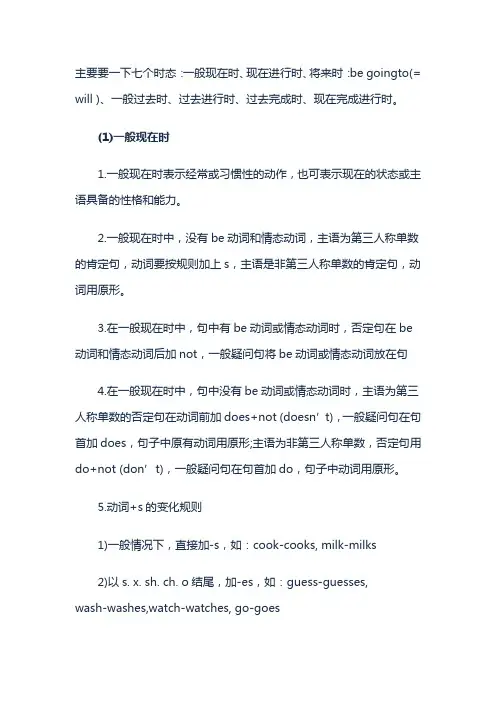
主要要一下七个时态:一般现在时、现在进行时、将来时:be goingto(= will )、一般过去时、过去进行时、过去完成时、现在完成进行时。
(1)一般现在时1.一般现在时表示经常或习惯性的动作,也可表示现在的状态或主语具备的性格和能力。
2.一般现在时中,没有be动词和情态动词,主语为第三人称单数的肯定句,动词要按规则加上s,主语是非第三人称单数的肯定句,动词用原形。
3.在一般现在时中,句中有be动词或情态动词时,否定句在be 动词和情态动词后加not,一般疑问句将be动词或情态动词放在句4.在一般现在时中,句中没有be动词或情态动词时,主语为第三人称单数的否定句在动词前加does+not (doesn’t),一般疑问句在句首加does,句子中原有动词用原形;主语为非第三人称单数,否定句用do+not (don’t),一般疑问句在句首加do,句子中动词用原形。
5.动词+s的变化规则1)一般情况下,直接加-s,如:cook-cooks, milk-milks2)以s. x. sh. ch. o结尾,加-es,如:guess-guesses,wash-washes,watch-watches, go-goes3)以“辅音字母+y”结尾,变y为i, 再加-es,如:study-studies6. 句中be动词和动词一般情况下只能有一种而且也必须有一种。
如:The childrenare very happy on Christmas Day .7.一般现在时中的be动词:一般用原形:am is aream用于第一人称单数(I);is用于第三人称单数(he she it和其他人名或称谓,如:Ben his sister等);are用于第二人称单数(you)和所有复数(包括第一人称复数we、第二人称复数you;第三人称复数they和其他复数,如his parents等)。
8.一般过去时中的动词:有两种情况:第一种情况:主语是第三人称单数(he she it 和其他,如Helen 、her cousin 等),动词后一般加s或es。
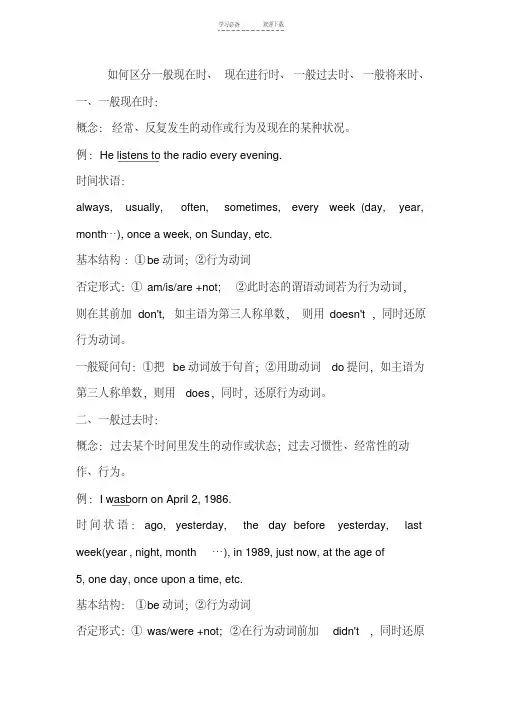
如何区分一般现在时、现在进行时、一般过去时、一般将来时、一、一般现在时:概念:经常、反复发生的动作或行为及现在的某种状况。
例:He listens to the radio every evening.时间状语:always, usually, often, sometimes, every week (day, year, month…), once a week, on Sunday, etc.基本结构:①be动词;②行为动词否定形式:①am/is/are +not;②此时态的谓语动词若为行为动词,则在其前加don't,如主语为第三人称单数,则用doesn't,同时还原行为动词。
一般疑问句:①把be动词放于句首;②用助动词do提问,如主语为第三人称单数,则用does,同时,还原行为动词。
二、一般过去时:概念:过去某个时间里发生的动作或状态;过去习惯性、经常性的动作、行为。
例:I wasborn on April 2, 1986.时间状语:ago, yesterday, the day before yesterday, last week(year, night, month…), in 1989, just now, at the age of5, one day, once upon a time, etc.基本结构:①be动词;②行为动词否定形式:①was/were +not;②在行为动词前加didn't,同时还原行为动词。
一般疑问句:①was或were放于句首;②用助动词do的过去式did 提问,同时还原行为动词。
三、现在进行时:概念:表示现阶段或说话时正在进行的动作及行为。
时间状语:at the monment look listen\now例:The woman is talking to the doctor.时间状语:now, at this time, these days, etc.基本结构:am /is/are +doing否定形式:am /is/are +not +doing.一般疑问句:把be动词放于句首。
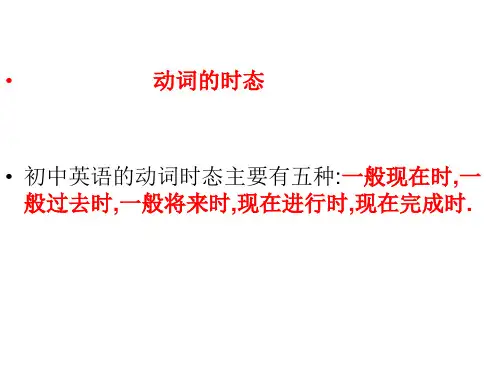
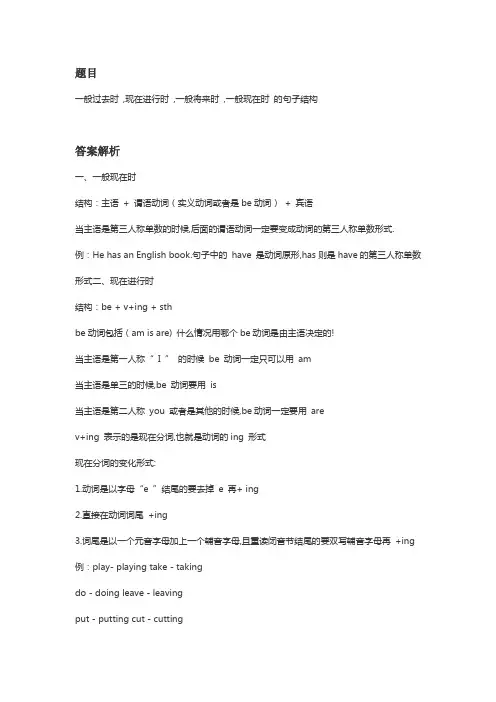
题目一般过去时,现在进行时,一般将来时,一般现在时的句子结构答案解析一、一般现在时结构:主语+ 谓语动词(实义动词或者是be动词)+ 宾语当主语是第三人称单数的时候,后面的谓语动词一定要变成动词的第三人称单数形式. 例:He has an English book.句子中的have 是动词原形,has则是have的第三人称单数形式二、现在进行时结构:be + v+ing + sthbe动词包括(am is are) 什么情况用哪个be动词是由主语决定的!当主语是第一人称“I ”的时候be 动词一定只可以用am当主语是单三的时候,be 动词要用is当主语是第二人称you 或者是其他的时候,be动词一定要用arev+ing 表示的是现在分词,也就是动词的ing 形式现在分词的变化形式:1.动词是以字母“e ”结尾的要去掉e 再+ ing2.直接在动词词尾+ing3.词尾是以一个元音字母加上一个辅音字母,且重读闭音节结尾的要双写辅音字母再+ing 例:play- playing take - takingdo - doing leave - leavingput - putting cut - cutting例:I am playing football with my classmates.He is watching TV at home.They are having an English class.三、一般将来时1.结构:be + going to +do sth例:I am going to do my homework tomorrow.He is going to babysit his sister.We are going to go shopping this weekend.2.will + v(原形)例:He will come back later.I will visit my grandparents next week.3.be + doing sth现在进行时也可以表示计划、打算要做的事情例:I am leaving for Shanghai next Sunday.四、一般过去时结构:主语+ 动词过去式(be 动词,或者实义动词) + 宾语例:I was a little girl 10 years ago.He went to the Great Wall last month.I visited my cousins last Saturday.。
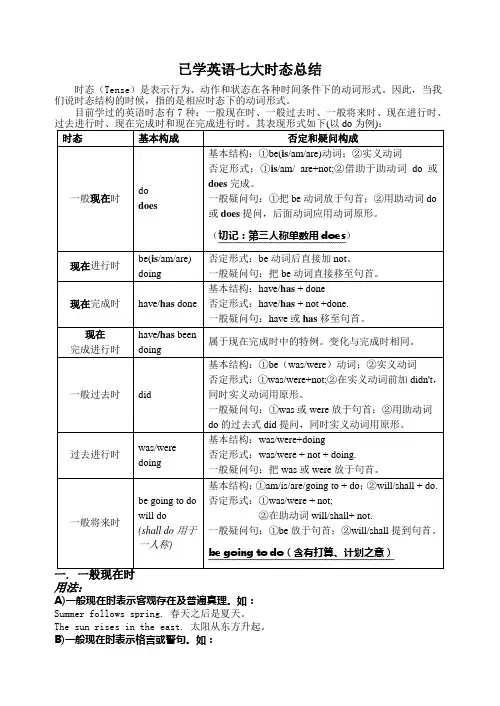
已学英语七大时态总结时态(Tense)是表示行为、动作和状态在各种时间条件下的动词形式。
因此,当我们说时态结构的时候,指的是相应时态下的动词形式。
目前学过的英语时态有7种:一般现在时、一般过去时、一般将来时、现在进行时、用法:A)一般现在时表示客观存在及普遍真理。
如:Summer follows spring. 春天之后是夏天。
The sun rises in the east. 太阳从东方升起。
B)一般现在时表示格言或警句。
如:Pride goes before a fall. 骄者必败。
C)一般现在时表示目前的情况或状态。
如:I am a teacher. 我是教师。
Peter writes good Chinese but does not speak well. 彼得汉语写得不错,讲的可不行。
D)以here, there等开始的倒装句,表示动作正在进行。
如:Here comes the bus. = The bus is coming. 车来了。
There goes the bell. = The bell is ringing. 铃响了。
E)在时间状语从句或if引导的条件状语从句中应用现在时表示将来:I will give it to him as soon as I see him. 我一看见他就交给他。
He will come if you invite him. 如果你请他,他会来的。
一般现在时常与下列时间状语连用:always, usually, often, sometimes, every week (day, year, month…), once a week, on Sundays, etc.二. 现在进行时(is/am/are doing)用法:A)表示此时此刻或现阶段正在进行的动作。
如:They’re having a meeting. 他们在开会。
I’m studying at an evening school. 我在上夜校。
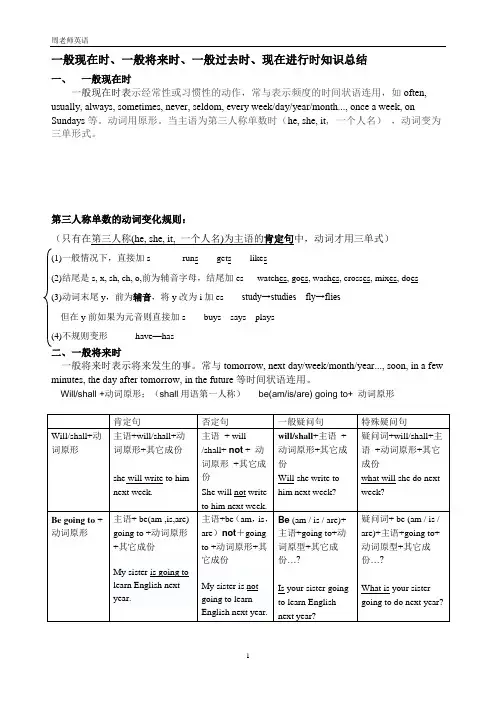
一般现在时、一般将来时、一般过去时、现在进行时知识总结一、一般现在时一般现在时表示经常性或习惯性的动作,常与表示频度的时间状语连用,如often, usually, always, sometimes, never, seldom, every week/day/year/month..., once a week, on Sundays等。
动词用原形。
当主语为第三人称单数时(he, she, it, 一个人名),动词变为三单形式。
第三人称单数的动词变化规则:(只有在第三人称(he, she, it, 一个人名)为主语的肯定句中,动词才用三单式)(1)一般情况下,直接加s runs gets likes(2)结尾是s, x, sh, ch, o,前为辅音字母,结尾加es watches, goes, washes, crosses, mixes, does(3)动词末尾y,前为辅音,将y改为i加es study→studies fly→flies但在y前如果为元音则直接加s buys says plays(4)不规则变形have—has二、一般将来时一般将来时表示将来发生的事。
常与tomorrow, next day/week/month/year..., soon, in a few minutes, the day after tomorrow, in the future等时间状语连用。
Will/shall +动词原形;(shall用语第一人称)be(am/is/are) going to+ 动词原形三、一般过去时一般过去时表示过去某一时候或某一段时间所发生了的事情或存在的状态。
常与过去时间yesterday,ago, this morning,just now,a moment ago,last night / year / week/month,once upon a time,the other day,before,the day before yesterday, in 1989, at the age of five, one day, then(那时), on that day,in the past连用。
初中语法般现在时、一般过去时、一般将来时、现在进行时四种时态的区别1、一般现在时——第三人称单数的动词变化规则:1)大多数动词在词尾加“ S'女口:stop—___ ; make— ______ read — _______ ; play—______2)以辅音字母加“ y”结尾的,要先将“ y”变为“ i”,然后在加“ es”女口:fly— ___ ; carry—_______ study—_______ ; worry—_______ 3)以“ s, x, ch, sh结尾的,在词尾加“ es”女口:teach — __ ; watch—_________4)以“ o”结尾的动词,加“ es”女口:go— __ do —________2、现在进行时——动词ing 形式的变化规则1. 一般动词直接在词尾+ing例:read—______ (读) talk—_______ (交谈) sinL ______ (唱歌) 2. 以不发音e 结尾的动词,先去e 再加ing例:like—_____ 喜欢write—______ 写skate—_______ (滑冰)3. 以重读闭音节结尾且末尾只有一个辅音字母的动词,双写末尾字母,再加ing 例:stop—_____ (停止) get—__________ (得到)4. 少数几个以ie 结尾的动词,变ie 为f 再加ing。
例:l i e —___ (躺、撒谎) t i e — ___ (系、捆绑)3、一般过去时——动词的变化规则(1) 一般在动词后加-ed。
如:play- _____ , offer- _____ , weigh- _____ , destroy- _____ , sign- _____(2) 在以字母e 结尾的动词后,只加-d。
如: like - ____ , provide-_____ , hate- _____ date- ________⑶在以“辅音字母+y”结尾的动词后,则改y为i,再加-ed。
简单的时态一般现在时一般过去时将来时和现在进行时时态对于表达动作发生的时间和状态的变化非常重要。
在英语中,一般现在时、一般过去时、将来时和现在进行时是最基本也最常用的时态形式。
下面将针对这四种时态进行简单解释。
一般现在时:一般现在时表示经常性或习惯性的动作、客观真理、现有状态、常规发生的事情以及一般的定理等。
这种时态的动词通常不带任何的时间状语。
例如:1. I eat breakfast every morning.(我每天早上吃早餐。
)2. She lives in London. (她住在伦敦。
)3. The sun rises in the east. (太阳从东边升起。
)一般过去时:一般过去时用于表示发生在过去的某个具体时间,或者描述过去的习惯、经历和已经结束的状态等。
通常和过去的时间状语一起使用。
例如:1. I visited my grandparents last weekend. (上个周末我去看望了我的祖父母。
)2. They lived in Paris when they were young. (他们年轻的时候住在巴黎。
)3. He worked as a teacher before he retired. (他退休前是一名教师。
)将来时:将来时用于表示将来某个时间将要发生的动作或者存在的状态。
常和表示将来时间的时间状语连用。
例如:1. We will have a meeting tomorrow morning. (明天上午我们将举行一个会议。
)2. She is going to visit her friend next week. (她下周将要去拜访她的朋友。
)3. They are leaving for the airport in an hour. (他们将在一个小时后去机场。
)现在进行时:现在进行时用来表示现在正在进行的动作,或者表示目前的临时状态。
例如:1. I am studying for my math exam. (我正在为我的数学考试学习。
+be(am/is/ are)+其他否主语+be(am/is/ are)+not+其他+动词原形+其他定主语(非三单)+don’t+动词原形+其他+动词三单形式+其他句主语(三单)+doesn’t+动词原形+其他always、usually、often、sometimes等频率副词;every week(day、year…)、once a week,on Sunday等时间状语;三、第三人称单数形式构成规则:1、大多数动词在词尾加“S”如:read-reads以不发音字母“e”结尾的开音节词,加“s” 如:make-makes2、以“s, x, ch, sh,o”结尾的,在词尾加“es”如:go-goes, guess-guesses, fix-fixes3、以辅音字母加“y”结尾的,要先将“y”变为“i”再加“es”,如:fly-flies, carry-carries, worry-worries,study-studies以元音字母加“y”结尾的,直接加“S”,如:play-plays, stop-stops, say-says4、特殊:○1be动词包括:am,is,are第三人称单数为is ○2have -has四、写出下列动词的第三人称单数形式:visit-- guess-- take-- go--rush-- feel-- cook-- wash--fly-- be-- say-- run--do-- worry-- live-- watch--enjoy-- have-- like-- play--use-- teach-- buy-- study--drink-- stay-- make-- plant--trip-- carry-- come-- cry--五、用括号内动词的适当形式填空。
1. She often __________ (have)lunch at home.2. Sarah and Tom __________ (be) in Class One.3. We__________ (not watch) TV on Monday.4. Oliver __________ (not go) to school on Sunday.5.__________ they __________ (like)playing football?6. What __________ they often__________ (do) on Saturdays?7. __________ your parents __________ (read) newspapers?8. The girl__________ (teach) us English on Sundays.9. She and I __________ (take) a walk together every evening.10. There __________ (be) some water in the bottle.11. Mike__________ (like) cooking.12. He__________ (have) two new books.13. My sister __________ (look) after her baby carefully.14. You always __________ (do) your homework well.15. I__________ (be) ill. I’m staying in bed.16. She __________ (go) to school from Monday to Friday.17. Liu Tao __________ (do) not like PE.18. The child often __________ (watch) TV in the evening.19. -What day __________(be) it today? -It’s Saturday20.-How_________ Dad __________(feel)?-He __________(feel) not well.21.-Where__________ he __________(work)?-He __________(work) at sea.一、含义:表示过去某一时间内发生的动作或存在的状态以及过去习惯性、反复性的动作。
七个时态:一般现在时、现在进行时、将来时:be goingto(= will )、一般过去时、过去进行时、过去完成时、现在完成进行时。
(1)一般现在时1.一般现在时表示经常或习惯性的动作,也可表示现在的状态或主语具备的性格和能力。
2.一般现在时中,没有be动词和情态动词,主语为第三人称单数的肯定句,动词要按规则加上s,主语是非第三人称单数的肯定句,动词用原形。
3.在一般现在时中,句中有be动词或情态动词时,否定句在be动词和情态动词后加not,一般疑问句将be动词或情态动词放在句4.在一般现在时中,句中没有be动词或情态动词时,主语为第三人称单数的否定句在动词前加does+not (doesn’t),一般疑问句在句首加does,句子中原有动词用原形;主语为非第三人称单数,否定句用do+not (don’t),一般疑问句在句首加do,句子中动词用原形。
5.动词+s的变化规则1)一般情况下,直接加-s,如:cook-cooks, milk-milks2)以s. x. sh. ch. o结尾,加-es,如:guess-guesses,wash-washes,watch-watches, go-goes3)以“辅音字母+y”结尾,变y为i, 再加-es,如:study-studies6. 句中be动词和动词一般情况下只能有一种而且也必须有一种。
如:The childrenare very happy on Christmas Day .7.一般现在时中的be动词:一般用原形:am is aream用于第一人称单数(I);is用于第三人称单数(he she it和其他人名或称谓,如:Ben his sister等);are用于第二人称单数(you)和所有复数(包括第一人称复数we、第二人称复数you;第三人称复数they和其他复数,如his parents等)。
8.一般过去时中的动词:有两种情况:第一种情况:主语是第三人称单数(he she it 和其他,如Helen 、her cousin 等),动词后一般加s或es。
一般现在时、一般过去时、一般将来时、现在进行时初中语法一般现在时、一般过去时、一般将来时、现在进行时是四种不同的时态。
它们分别用于描述不同的时间和动作形式。
一般现在时表示经常性或惯性的动作,通常使用动词的原形或第三人称单数形式。
常用的时间状语有always、sometimes、usually、often、every morning、every week、twice a week等等。
现在进行时表示此时此刻或现阶段正在进行的动作,通常使用am/is/are+动词的ing形式。
常用的时间状语有now、right now、at the moment、look、listen等。
一般将来时表示将来发生的事情或计划,通常使用will/shall+动词的原形或am/is/are+going to+动词的原形。
常用的时间状语有in the future、next week/month、tomorrow、in two weeks等等。
一般过去时表示过去某一时刻或过去某一段时间所发生的动作,与现在无关。
动词的变化规则有以下几种:1)大多数动词在词尾加“S”;2)以辅音字母加“y”结尾的,要先将“y”变为“i”,然后在加“es”;3)以“s。
x。
ch。
sh”结尾的,在词尾加“es”;4)以“o”结尾的动词,加“es”。
现在进行时使用动词的ing形式,变化规则有以下几种:1)一般动词直接在词尾+ing;2)以不发音e结尾的动词,先去e再加ing;3)以重读闭音节结尾且末尾只有一个辅音字母的动词,双写末尾字母,再加ing。
3、一般过去时——动词的变化规则一般过去时是描述过去发生的事情,动词的变化规则如下:1)一般在动词后加-ed。
如:play-played。
offer-offered。
weigh-weighed。
destroy-destroyed。
sign-signed2)在以字母e结尾的动词后,只加-d。
如:like-liked。
英语最基本的五个时态英语最常用的时态有五个:一般现在时;现在进行时;一般过去时;一般将来时和现在完成时。
一、一般现在时:用动词原型表示,但单数第三人称后要加-s,在词尾加-s时要注意:1.一般情况:加-s 例:reads,writes,says2.以s,x,ch,sh收尾的词加-es 例:teaches,washes,guesses3.以辅音字母+y结尾的词变y为i再加-es 例:try—tries,carry—carries。
这个时态的疑问句一般以句首加助动词do,does构成。
句中动词要用原型动词be提前:do you know it?are you students?does she have a pen?1.一般现在时表示经常性或习惯性的动作:we always care for each other and help each other。
they cycle to work every day。
2.现在的特征或状态:he loves sports。
do you sing?a little。
i major in english。
3.普遍真理:light travels faster than sound。
two and four makes six。
the moon moves round the earth。
有些表示状态和感觉的动词常常可用于一般现在时:be,love,like,hate,want,hope,need,prefer,wish,know,understand,remember,believe,recognize,guess,suppose,mean,belong,think(以为),feel,envy,doubt,remain,consist,contain,seem,look(看起来),see,fit,suit,owe,own,hear,find,suggest,propose,allow,show(说明),prove,mind(在意),have (有),sound(听起来),taste(尝起来),matter,require,possess,desire 等等。
初中语法1、一般现在时——第三人称单数的动词变化规则:1)大多数动词在词尾加“S”如:stop —______ ; make —______ read —_______ ; play —_____ 2)以辅音字母加“y”结尾的,要先将“”变为“然后在加es”女口: fly — _ ; carry —______ study —________ ; worry —______ 3)以S, x, ch, sh ”结尾的,在词尾加e s”女口: teach —___ ; watch — ________4)以o”结尾的动词,加es”女口: go — __ do —________唱歌)ing 2、现在进行时——动词 ing 形式的变化规则1. 一般动词直接在词尾 +ing例:read n_ ____ (读) talk ______ (交谈) si ng — 2. 以不发音 e 结尾的动词,先去 e 再加 ing例: like- ____ 喜欢 write- __________ 写 skate- _________ (滑冰)3. 以重读闭音节结尾且末尾只有一个辅音字母的动词,双写末尾字母,再加 例: stop- _____ (停止) get- _________ (得到)4. 少数几个以 ie 结尾的动词,变 ie 为 f 再加 ing 。
例: lie- ___ (躺、撒谎) tie- ______ (系、捆绑)3、一般过去时——动词的变化规则(1) 一般在动词后加-ed 。
如:play- ____ , offer- ____ , weigh- ____ , destroy- ____ , sign- ___(2) 在以字母 e 结尾的动词后,只加 -d 。
如 :like- __ , provide- ____ , hate - ____ date- ________⑶在以“辅音字母+y ”结尾的动词后,则改y 为i,再加-ed 。
如 :supply- ___ , study- ____ .(4) 在以单短元音的重读闭音节结尾且,末尾只有一个辅音字母的动词后,写最后一个辅音字母,再加 -ed 。
如 :plan- ___ , refer- ____ r egret- _____ , ban- _______5)还有一些不规则变化的要单独记如: do--did know--knew am/is--was cut--cut become--became练一练:一、写出下列动词的形式1)写出下列动词的第三人称单数形式know ______ l isten _______ brush ________ w atch _________go _____ do ___________ have __________2)写出下列动词的 ing 形式go- _____ , work- _____ close - ______ , come- ________become-_______ get - ____ sit - _______3)写出下列动词的过去式二、用所给动词的正确形式填空。
1. He often _____ (read) 21 st Century Teens.2. Is he ______ (enjoy) his stay here?3. We _______ (build) a lab next year.4. He _______ (write) at the moment.5. I ______ (be) in Beijing last year.6. He _______ (be) taller than I.7. Where ______ he ________ (tell) herthe news?8. I'm going to ______ (work) hard.9. She can ______ (help) me with my English.10. They _____ (read) newspapers now.综合练习:一、用括号里的词的适当形式填空1. We often ____________ (play) on the playground.2. He _________ (get) up at six o'clock.3. _________ you __________ (brush) your teeth every morning ?4. What (do) he usually (do) after school?5. Danny (study) English, Chinese, Math, Science and Art at school.6. Mike __________ (go)to the park with his sister yesterday.7. Last night, she ______ (watch) TV with his parents.8. _______ Mike _________ (read) English tomorrow?9. How many lessons _______ your classmate ___ (have) next week?10. What time __ his mother _________ (do) the housework tomorrow?11. Don 't make a noise. Grandpa _______ (sleep).12. It _____ (take) me two hours to finish my homework last night.13. What _____ your mother _______ (do) every evening? She ___ (wash) clo thes.14. Look! She ________ (do) her homework.15. There ______ (be) a football match on TV next Sunday.16. They _______ (visit) the Great Wall now.17. The earth _________ (move) round the sun.18. I ___ (be) born in 1992.19. ______ you _____ ( go) school yesterday? No, I ____ ( not).20. How long ____ you _______ (stay) in Paris last time?二、写出下列动词的第三人称单数形式:1. wash _________ match _______ guess ______ study ______ finish ________tell ______ break _________ draw _______ e at ________ read ______ put ________ give ______ keep _________ go ________ snow ______ carry __________2. stop _____ see _________ drive _______ let ______ carry _____ keep ______ joi n _____ find _______ think _______ teach ______ catch ______3. _________ s tay ________ begin ________ forget ___ lie _______ die ______ run prefer _____ give ________ ring ______ d ance _____ hope ________、写出下列动词的过去式build ______ catch __________ begin __________ come _______ buy _________ c ut __________ think _______ go __________ g et ________know _______ 四、单项选择( )1. _________ y ou ___________ your homework now?A. Are, doB. Do, doC. Will, doD. Are, doing( )2. Look, they __________ a good time.A. hasB. haveC. are havingD. had( )3. - can 'find my pen. Can I use yours?——Sorry, I ______ it now.A. am usingB. was usingC. have usedD. used( )4. — ___________ you ____________ to the radio?—No, you can turn it off.A. Did, listenB. Have, listenedC. Do, listenD. Are, listening( )5. Look! Some children _______ g ames on the playground.A. is playingB. are playingC. are playedD. is going to play( )6. _________ your mother ________ some cleaning on Sundays? A. Does, does B. Do, does C. Does, do D. Do, do( )7. Mr. Black often _______ fishing on Sundays.A. goB. goesC. don 't goD. isn't go( )8. We __________ go to play outside in winter.A. doB. doesC. don'tD. doesn 't( )9. _________ your father usually go to work early every day?A. WasB. WereC. DoD. Does( )10. ________ you _________ English every morning?A. Are, readB. Do, readC. Does, readD. Are, reading( )11. Look at those clouds. It ____________ soon.A. is going to rainB. is rainingC. will rainD. won't rain( )12. The radio says it ________________ the day after tomorrow.A. is going to snowB. is snowingC. will snowD. snows( )13. _____________ Tom and Jim in the classroom just now?A. WasB. AreC. WereD. Is( )14. When I __________________ her in the hall, she was playing the piano.A. seeB. sawC. will seeD.am seeing( )15. He turned off the lights and then _____________ the classroom.A. leavesB. will leaveC. is leavingD. leftWelcome To Download !!!欢迎您的下载,资料仅供参考!。